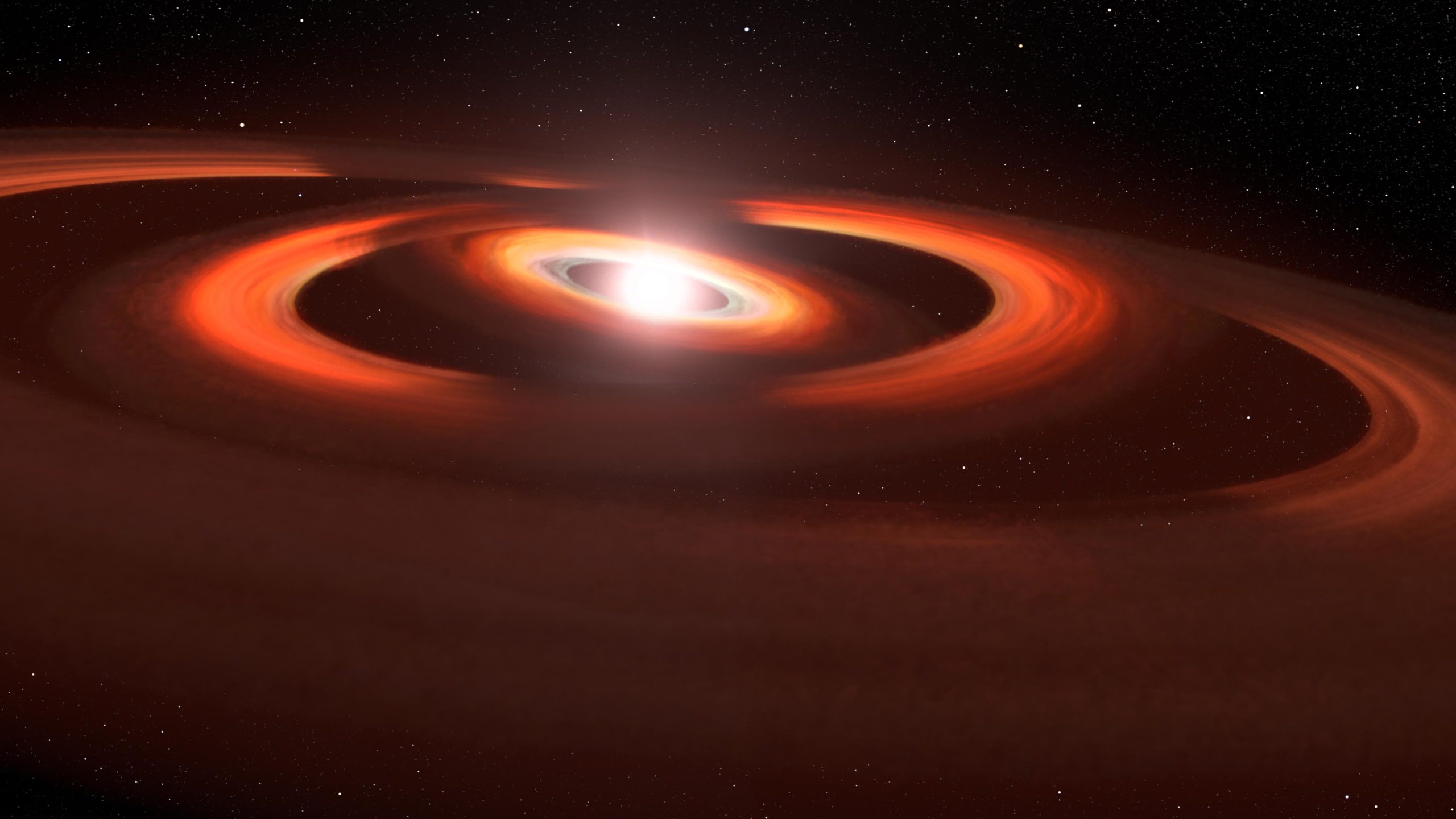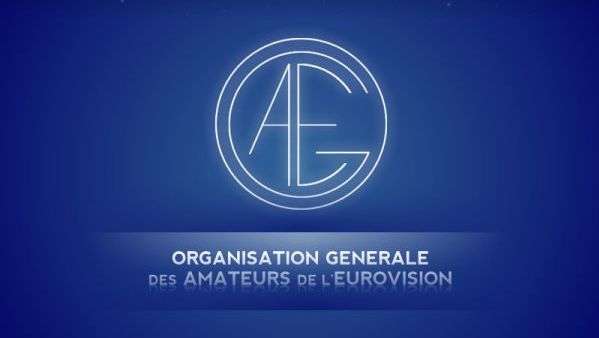
Il concetto di questo artista si basa sulle immagini del telescopio spaziale Hubble di dischi di gas e polvere attorno alla giovane stella TW Hydrae. Le immagini del telescopio spaziale Hubble mostrano ombre che inghiottono i dischi che circondano il sistema. La spiegazione è che queste ombre provengono da dischi interni leggermente inclinati che impediscono alla luce delle stelle di raggiungere il disco esterno, proiettando così un’ombra. I dischi sono leggermente inclinati l’uno verso l’altro a causa della forza gravitazionale dei pianeti invisibili che distorcono la struttura del disco. Crediti: NASA, Aura/STScI, Agenzia spaziale europea, Leah Hostack (STScI)
Pianeti appena nati invisibili sollevano polvere attorno a una giovane stella
Il nostro mondo è così volubile che a volte gli piace giocare a nascondino. Nel 2017, gli astronomi sono rimasti sorpresi nel vedere un’enorme ombra inghiottire un disco di polvere e gas che circondava la vicina giovane stella TW Hydrae. L’ombra è proiettata da un disco interno di polvere e gas leggermente inclinato rispetto al piano del disco esterno. L’ombra può essere vista chiaramente solo perché il sistema è inclinato faccia a faccia sulla Terra, offrendo agli astronomi una vista a volo d’uccello del disco mentre l’ombra sfreccia attorno al disco come una lancetta che si muove su un orologio.
Ma l’orologio ha due lancette (per ore e minuti) che scorrono a velocità diverse. E si scopre che anche TW Hydrae lo è. Gli astronomi hanno utilizzato Hubble per trovare una seconda ombra che emerge da un altro disco interno, inclinata verso i due dischi esterni. Pertanto, il sistema appare sempre più complesso con almeno tre dischi sovrapposti leggermente inclinati l’uno rispetto all’altro. I dischi sono proxy per pianeti invisibili intorno alla stella. Ogni pianeta attira materiale vicino alla stella con la sua forza gravitazionale e deforma quello che sarebbe un disco a forma di frittella perfettamente piatto se i pianeti non fossero lì. Ciò non sorprende perché i pianeti del nostro sistema solare hanno piani orbitali che differiscono in inclinazione di pochi gradi l’uno dall’altro. TW Hydrae offre agli astronomi un posto in prima fila per vedere come poteva essere il nostro sistema solare durante i suoi anni formativi.

Le immagini di confronto del telescopio spaziale Hubble, a diversi anni di distanza, hanno rivelato due ombre inquietanti che si muovono in senso antiorario attraverso un disco di gas e polvere che circonda la giovane stella TW Hydrae. I dischi si inclinano faccia a faccia sulla Terra, offrendo così agli astronomi una visione a volo d’uccello di ciò che sta accadendo intorno alla stella. La foto a sinistra, scattata nel 2016, mostra solo un’ombra [A] Sono le 11:00. Questa ombra è proiettata da un disco interno che è leggermente inclinato rispetto al disco esterno e blocca la luce delle stelle. L’immagine a sinistra mostra una seconda ombra che è apparsa da un altro disco interposto [C] 7:00, come girato nel 2021. Disco interno originale contrassegnato [B] in questo spettacolo successivo. Le ombre ruotano attorno alla stella a velocità diverse come in senso orario. Sono la prova di due pianeti invisibili che hanno attirato la polvere nelle loro orbite. Questo li fa appoggiare leggermente l’uno contro l’altro. Questa è un’immagine a luce visibile scattata con lo spettroradiometro per immagini del telescopio spaziale. Il colore sintetico è stato aggiunto per migliorare i dettagli. Crediti: NASA, ESA, STScI, John Debes (AURA/STScI per ESA), Joseph DePasquale (STScI)
Il telescopio spaziale Hubble segue un gioco di ombre attorno al disco di formazione del pianeta
La giovane star TW Hydrae interpreta i “burattini ombra” con gli scienziati che lo osservano[{” attribute=””>NASA’s Hubble Space Telescope.
In 2017, astronomers reported discovering a shadow sweeping across the face of a vast pancake-shaped gas-and-dust disk surrounding the red dwarf star. The shadow isn’t from a planet, but from an inner disk slightly inclined relative to the much larger outer disk – causing it to cast a shadow. One explanation is that an unseen planet’s gravity is pulling dust and gas into the planet’s inclined orbit.
Now, a second shadow – playing a game of peek-a-boo – has emerged in just a few years between observations stored in Hubble’s MAST archive. This could be from yet another disk nestled inside the system. The two disks are likely evidence of a pair of planets under construction.
TW Hydrae is less than 10 million years old and resides about 200 light-years away. In its infancy, our solar system may have resembled the TW Hydrae system, some 4.6 billion years ago. Because the TW Hydrae system is tilted nearly face-on to our view from Earth, it is an optimum target for getting a bull’s-eye-view of a planetary construction yard.
The second shadow was discovered in observations obtained on June 6, 2021, as part of a multi-year program designed to track the shadows in circumstellar disks. John Debes of AURA/STScI for the European Space Agency at the Space Telescope Science Institute in Baltimore, Maryland, compared the TW Hydrae disk to Hubble observations made several years ago.
“We found out that the shadow had done something completely different,” said Debes, who is principal investigator and lead author of the study published in The Astrophysical Journal. “When I first looked at the data, I thought something had gone wrong with the observation because it wasn’t what I was expecting. I was flummoxed at first, and all my collaborators were like: what is going on? We really had to scratch our heads and it took us a while to actually figure out an explanation.”
The best solution the team came up with is that there are two misaligned disks casting shadows. They were so close to each other in the earlier observation they were missed. Over time they’ve now separated and split into two shadows. “We’ve never really seen this before on a protoplanetary disk. It makes the system much more complex than we originally thought,” he said.
The simplest explanation is that the misaligned disks are likely caused by the gravitational pull of two planets in slightly different orbital planes. Hubble is piecing together a holistic view of the architecture of the system.
The disks may be proxies for planets that are lapping each other as they whirl around the star. It’s sort of like spinning two vinyl phonograph records at slightly different speeds. Sometimes labels will match up but then one gets ahead of the other.
“It does suggest that the two planets have to be fairly close to each other. If one was moving much faster than the other, this would have been noticed in earlier observations. It’s like two race cars that are close to each other, but one slowly overtakes and laps the other,” said Debes.
The suspected planets are located in a region roughly the distance of Jupiter from our Sun. And, the shadows complete one rotation around the star about every 15 years – the orbital period that would be expected at that distance from the star.
Also, these two inner disks are inclined about five to seven degrees relative to the plane of the outer disk. This is comparable to the range of orbital inclinations inside our solar system. “This is right in line with typical solar system style architecture,” said Debes.
The outer disk that the shadows are falling on may extend as far as several times the radius of our solar system’s Kuiper belt. This larger disk has a curious gap at twice Pluto’s average distance from the Sun. This might be evidence for a third planet in the system.
Any inner planets would be difficult to detect because their light would be lost in the glare of the star. Also, dust in the system would dim their reflected light. ESA’s Gaia space observatory may be able to measure a wobble in the star if Jupiter-mass planets are tugging on it, but this would take years given the long orbital periods.
The TW Hydrae data are from Hubble’s Space Telescope Imaging Spectrograph. The James Webb Space Telescope’s infrared vision may also be able to show the shadows in more detail.
Reference: “The Surprising Evolution of the Shadow on the TW Hya Disk” by John Debes, Rebecca Nealon, Richard Alexander, Alycia J. Weinberger, Schuyler Grace Wolff, Dean Hines, Joel Kastner, Hannah Jang-Condell, Christophe Pinte, Peter Plavchan and Laurent Pueyo, 4 May 2023, The Astrophysical Journal.
DOI: 10.3847/1538-4357/acbdf1
The Hubble Space Telescope is a project of international cooperation between NASA and ESA. NASA’s Goddard Space Flight Center in Greenbelt, Maryland, manages the telescope. The Space Telescope Science Institute (STScI) in Baltimore conducts Hubble science operations. STScI is operated for NASA by the Association of Universities for Research in Astronomy, in Washington, D.C.

“Sottilmente affascinante social mediaholic. Pioniere della musica. Amante di Twitter. Ninja zombie. Nerd del caffè.”





More Stories
La Voyager 1 invia i dati dopo che la NASA ha riparato da remoto la sonda vecchia di 46 anni | spazio
Un nuovo principio pionieristico: i ricercatori coreani hanno scoperto un fenomeno rivoluzionario nei cristalli liquidi
L’imaging ad alta velocità e l’intelligenza artificiale ci stanno aiutando a capire come funzionano le ali degli insetti